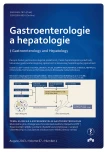Successful endoscopic treatment of macroscopically advanced esophageal adenocarcinoma in a high-risk patient
Authors:
Z. Vacková 1; M. Stefanová 2; I. Tučková 3; A. Pazdro 5; M. Smejkal 5; M. Zemanová 4; J. Špičák 1; J. Martínek 1
Authors‘ workplace:
Klinika hepatogastroenterologie, IKEM, Praha
1; Interní oddělení, Nemocnice Na Františku, Praha
2; Patologické oddělení, ÚVN, Praha
3; Onkologická klinika 1. LF UK a VFN, Praha
4; III. chirurgická klinika 1. LF UK a FN v Motole, Praha
5
Published in:
Gastroent Hepatol 2013; 67(4): 271-274
Category:
Clinical and Experimental Gastroenterology: Case Report
Overview
Combination of endoscopic mucosal resection (or submucosal dissection) with radiofrequency ablation is a method of choice for treatment of early esophageal neoplasia. Endoscopic therapy should be preferred for management of patients with intramucosal neoplasia. However, endoscopic treatment should also be considered in patients with more advanced lesions (e.g. superficial submucosal cancer), particularly in those where surgery is an unacceptable risk or contraindicated due to severe comorbidities. We present a case of a successful endoscopic treatment of macroscopically, as well as histologically, advanced esophageal adenocarcinoma in a patient with liver cirrhosis Child-Pugh B. Endoscopic therapy consisted of two sessions of endoscopic mucosal resection and two sessions of radiofrequency ablation.
Key words:
Barrett's esophagus – endoscopic mucosal resection – radiofrequency ablation – esophageal adenocarcinoma
The authors declare they have no potential conflicts of interest concerning drugs, products, or services used in the study.
The Editorial Board declares that the manuscript met the ICMJE „uniform requirements“ for biomedical papers.
Submitted:
23. 7. 2013
Accepted:
5. 8. 2013
Sources
1. Pouw RE, Wirths K, Eisendrath P et al. Efficacy of radiofrequency ablation combined with endoscopic resection for barrett's esophagus with early neoplasia. Clin Gastroenterol Hepatol 2010; 8(1): 23–29.
2. Spechler SJ, Sharma P, Souza RF et al. American Gastroenterological Association medical position statement on the management of Barrett's esophagus. Gastroenterology 2011; 140(3): 1084–1091.
3. Mariette C. Is there a place for esogastric cancer surgery in cirrhotic patients? Ann Surg Oncol 2008; 15(3): 680–682.
4. Alvarez Herrero L, Pouw RE, van Vilsteren FG et al. Risk of lymph node metastasis associated with deeper invasion by early adenocarcinoma of the esophagus and cardia: study based on endoscopic resection specimens. Endoscopy 2010; 42(12): 1030–1036.
5. Sgourakis G, Gockel I, Lang H. Endoscopic and surgical resection of T1a//T1b esophageal neoplasms: a systematic review. World J Gastroenterol 2013; 19(9): 1424–1437.
6. Manner H, Pech O, Heldmann Y et al. Efficacy, safety, and long-term results of endoscopic treatment for early stage adenocarcinoma of the esophagus with low-risk sm1 invasion. Clin Gastroenterol Hepatol 2013; 11(6): 630–635.
7. Westerterp M, Koppert LB, Buskens CJ et al. Outcome of surgical treatment for early adenocarcinoma of the esophagus or gastro-esophageal junction. Virchows Arch 2005; 446(5): 497–504.
8. Hölscher AH, Vallböhmer D, Bollschweiler E. Early Barrett's carcinoma of the esophagus. Ann Thorac Cardiovasc Surg 2008; 14(6): 347–354.
9. Williams VA, Watson TJ, Herbella FA et al. Esophagectomy for high grade dysplasia is safe, curative, and results in good alimentary outcome. J Gastrointest Surg 2007; 11(12): 1589–1597.
10. Rice TW. Pro: esophagectomy is the treatment of choice for high-grade dysplasia in Barrett's esophagus. Am J Gastroenterol 2006; 101(10): 2177–2179.
Labels
Paediatric gastroenterology Gastroenterology and hepatology SurgeryArticle was published in
Gastroenterology and Hepatology

2013 Issue 4
Most read in this issue
- Esophageal manometry
- Pentasa Sachet 2 g
- Proton pump inhibitors: side effects and interaction
- Peroral endoscopic myotomy (POEM) for the treatment of a rare type III achalasia
